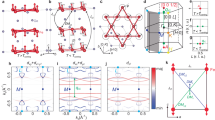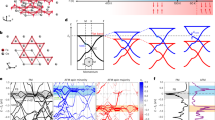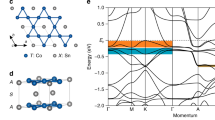Abstract
A kagome lattice of 3d transition metal ions is a versatile platform for correlated topological phases hosting symmetry-protected electronic excitations and magnetic ground states. However, the paradigmatic states of the idealized two-dimensional kagome lattice—Dirac fermions and flat bands—have not been simultaneously observed. Here, we use angle-resolved photoemission spectroscopy and de Haas–van Alphen quantum oscillations to reveal coexisting surface and bulk Dirac fermions as well as flat bands in the antiferromagnetic kagome metal FeSn, which has spatially decoupled kagome planes. Our band structure calculations and matrix element simulations demonstrate that the bulk Dirac bands arise from in-plane localized Fe-3d orbitals, and evidence that the coexisting Dirac surface state realizes a rare example of fully spin-polarized two-dimensional Dirac fermions due to spin-layer locking in FeSn. The prospect to harness these prototypical excitations in a kagome lattice is a frontier of great promise at the confluence of topology, magnetism and strongly correlated physics.
This is a preview of subscription content, access via your institution
Access options
Access Nature and 54 other Nature Portfolio journals
Get Nature+, our best-value online-access subscription
$29.99 / 30 days
cancel any time
Subscribe to this journal
Receive 12 print issues and online access
$259.00 per year
only $21.58 per issue
Buy this article
- Purchase on Springer Link
- Instant access to full article PDF
Prices may be subject to local taxes which are calculated during checkout




Similar content being viewed by others
Data availability
The data that support the plots within this paper and other findings of this study are available from the corresponding author upon reasonable request.
Code availability
The codes used for the DFT and tight-binding calculations in this study are available from the corresponding authors upon reasonable request.
References
Sachdev, S. Kagome- and triangular-lattice Heisenberg antiferromagnets: ordering from quantum fiuctuations and quantum-disordered ground states with unconfined bosonic spinons. Phys. Rev. B 45, 12377–12396 (1992).
Balents, L. Spin liquids in frustrated magnets. Nature 464, 199–208 (2010).
Guo, H. M. & Franz, M. Topological insulator on the kagome lattice. Phys. Rev. B 80, 113102 (2009).
Mazin, I. I. et al. Theoretical prediction of a strongly correlated Dirac metal. Nat. Commun. 5, 4261 (2014).
Xu, G., Lian, B. & Zhang, S.-C. Intrinsic quantum anomalous Hall effect in the kagome lattice Cs2LiMn3F12. Phys. Rev. Lett. 115, 186802 (2015).
Chen, H., Niu, Q. & Macdonald, A. H. Anomalous hall effect arising from noncollinear antiferromagnetism. Phys. Rev. Lett. 112, 17205 (2014).
Kübler, J. & Felser, C. Non-collinear antiferromagnets and the anomalous Hall effect. Europhys. Lett. 108, 67001 (2014).
Tang, E., Mei, J.-W. & Wen, X.-G. High-temperature fractional quantum Hall states. Phys. Rev. Lett. 106, 236802 (2011).
Burkov, A. A. & Balents, L. Weyl semimetal in a topological insulator multilayer. Phys. Rev. Lett. 107, 127205 (2011).
Wen, J., Rüegg, A., Wang, C. C. J. & Fiete, G. A. Interaction-driven topological insulators on the kagome and the decorated honeycomb lattices. Phys. Rev. B 82, 75125 (2010).
Bolens, A. & Nagaosa, N. Topological states on the breathing kagome lattice. Phys. Rev. B 99, 165141 (2019).
Nakatsuji, S., Kiyohara, N. & Higo, T. Large anomalous Hall effect in a non-collinear antiferromagnet at room temperature. Nature 527, 212–215 (2015).
Nayak, A. K. et al. Large anomalous Hall effect driven by non-vanishing Berry curvature in non-collinear antiferromagnet Mn3Ge. Sci. Adv. 2, e1501870 (2016).
Kuroda, K. et al. Evidence for magnetic Weyl fermions in a correlated metal. Nat. Mater. 16, 1090–1095 (2017).
Liu, Z. Q. et al. Electrical switching of the topological anomalous Hall effect in a non-collinear antiferromagnet above room temperature. Nat. Electron. 1, 172–177 (2018).
Ye, L. et al. Massive Dirac fermions in a ferromagnetic kagome metal. Nature 555, 638–642 (2018).
Yin, J. X. et al. Giant and anisotropic many-body spin–orbit tunability in a strongly correlated kagome magnet. Nature 562, 91–95 (2018).
Ye, L. et al. De Haas–van Alphen effect of correlated Dirac states in kagome metal Fe3Sn2. Nat. Commun. 10, 4870 (2019).
Lin, Z. et al. Flatbands and emergent ferromagnetic ordering in Fe3Sn2 kagome lattices. Phys. Rev. Lett. 121, 96401 (2018).
Liu, E. et al. Giant anomalous Hall effect in a ferromagnetic kagome-lattice semimetal. Nat. Phys. 14, 1125–1131 (2018).
Wang, Q. et al. Large intrinsic anomalous Hall effect in half-metallic ferromagnet Co3Sn2S2 with magnetic Weyl fermions. Nat. Commun. 9, 3681 (2018).
Ghimire, M. P. et al. Creating Weyl nodes and controlling their energy by magnetization rotation. Preprint at https://arxiv.org/abs/1903.03179 (2019).
Yin, J.-X. et al. Negative flat band magnetism in a spin–orbit-coupled correlated kagome magnet. Nat. Phys. 15, 443–448 (2019).
Hartmann, O. & Wappling, R. Muon spin precession in the hexagonal antiferromagnet FeSn. Phys. Scr. 35, 499–503 (1987).
Richard, P. et al. Observation of Dirac cone electronic dispersion in BaFe2As2. Phys. Rev. Lett. 104, 137001 (2010).
Tan, S. Y. et al. Observation of Dirac cone band dispersions in FeSe thin films by photoemission spectroscopy. Phys. Rev. B 93, 104513 (2016).
Zhang, P. et al. Observation of topological superconductivity in iron-based superconductor. Science 360, 182–186 (2018).
Chiang, T. Photoemission studies of quantum well states in thin films. Surf. Sci. Rep. 39, 181–235 (2000).
Moser, S. et al. Tunable polaronic conduction in anatase TiO2. Phys. Rev. Lett. 110, 196403 (2013).
Ohta, T., Bostwick, A., Seyller, T., Horn, K. & Rotenberg, E. Controlling the electronic structure of bilayer graphene. Science 313, 951–954 (2006).
Zhou, S. Y. et al. First direct observation of Dirac fermions in graphite. Nat. Phys. 2, 595–599 (2006).
Marchenko, D. et al. Highly spin-polarized Dirac fermions at the graphene/Co interface. Phys. Rev. B 91, 235431 (2015).
Sun, Q. F., Jiang, Z. T., Yu, Y. & Xie, X. C. Spin superconductor in ferromagnetic graphene. Phys. Rev. B 84, 214501 (2011).
Wang, Y. H. et al. Observation of a warped helical spin texture in Bi2Se3 from circular dichroism angle-resolved photoemission spectroscopy. Phys. Rev. Lett. 107, 207602 (2011).
Hwang, C. et al. Direct measurement of quantum phases in graphene via photoemission spectroscopy. Phys. Rev. B 84, 125422 (2011).
Liu, Y., Bian, G., Miller, T. & Chiang, T. C. Visualizing electronic chirality and Berry phases in graphene systems using photoemission with circularly polarized light. Phys. Rev. Lett. 107, 166803 (2011).
Neupert, T., Santos, L., Chamon, C. & Mudry, C. Fractional quantum Hall states at zero magnetic field. Phys. Rev. Lett. 106, 236804 (2011).
Sun, K., Gu, Z., Katsura, H. & Das Sarma, S. Nearly flatbands with nontrivial topology. Phys. Rev. Lett. 106, 236803 (2011).
Patil, S. et al. ARPES view on surface and bulk hybridization phenomena in the antiferromagnetic Kondo lattice CeRh2Si2. Nat. Commun. 7, 11029 (2016).
Cao, Y. et al. Correlated insulator behaviour at half-filling in magic-angle graphene superlattices. Nature 556, 80–84 (2018).
Koepernik, K. & Eschrig, H. Full-potential nonorthogonal local-orbital minimum-basis band-structure scheme. Phys. Rev. B 59, 1743–1757 (1999).
Perdew, J. P., Burke, K. & Ernzerhof, M. Generalized gradient approximation made simple. Phys. Rev. Lett. 77, 3865–3868 (1996).
Koepernik, K. FPLO (IFW Dresden, 2018).
Acknowledgements
We are grateful to C. Felser, S. Borisenko, M. Knupfer, K. Koepernik, L. Levitov and A. Fahimniya for fruitful discussions. M.P.G., J.-S.Y., J.I.F., S.F., M.R. and J.v.d.B. thank U. Nitzsche for technical assistance in maintaining computing resources at IFW Dresden. R.C. acknowledges support from the Alfred P. Sloan Foundation. This research was funded, in part, by the Gordon and Betty Moore Foundation EPiQS Initiative, Grant no. GBMF3848 to J.G.C. and ARO Grant no. W911NF-16-1-0034. M.K., L.Y., S.F., E.K. and M.P.G. acknowledge support by the STC Center for Integrated Quantum Materials, NSF grant number DMR-1231319. M.K. acknowledges support from the Samsung Scholarship from the Samsung Foundation of Culture. L.Y. acknowledges support from the Tsinghua Ed fucation Foundation. The computations in this paper were run on the ITF/IFW computer clusters (Dresden, Germany) and Odyssey cluster supported by the FAS Division of Science, Research Computing Group at Harvard University. M.R and J.v.d.B. acknowledge support from the German Research Foundation (DFG) via SFB 1143, project A5. M.P.G. thanks the Alexander von Humboldt Foundation for financial support through the Georg Forster Research Fellowship Program, Germany. J.-S.Y. and J.I.F. thank the IFW excellence programme. This research used the resources of the Advanced Light Source, a US Department of Energy (DOE) Office of Science User Facility under contract no. DE-AC02-05CH11231. A portion of this work was performed at the National High Magnetic Field Laboratory, which is supported by the National Science Foundation Cooperative Agreement no. DMR-1644779, the State of Florida and the DOE. Pulsed magnetic field measurements were supported by the DOE BES ‘Science at 100 T’ grant. Operation of the ESM beamline at the National Synchrotron Light Source is supported by DOE Office of Science User Facility Program operated for the DOE Office of Science by Brookhaven National Laboratory under Contract no. DE-AC02-98CH10886. D.C.B. acknowledges use of the Center for Nanoscale Systems, a member of the National Nanotechnology Coordinated Infrastructure Network, which is supported by the National Science Foundation under NSF award no. 1541959. J.v.d.B. was supported by the DFG through the Wurzburg-Dresden Cluster of Excellence on Complexity and Topology in Quantum Matter - ct.qmat (EXC 2147, project ID 39085490).
Author information
Authors and Affiliations
Contributions
M.K. performed the ARPES experiment and analysed the resulting data while A.L., C.J., A.B., E.R., K.K. and E.V. assisted. L.Y. synthesized and characterized the single crystals and performed the quantum oscillation experiments while M.K.C., R.D.M. and D.G. assisted. M.P.G. and S.F. performed the theoretical calculations while J.-S.Y., J.I.F. J.v.d.V., M.R. and E.K. assisted. M.H. and M.K. conducted the AFM measurements. D.C.B. performed the electron microscopy study. All authors contributed to writing the manuscript. J.G.C. and R.C. supervised the project.
Corresponding authors
Ethics declarations
Competing interests
The authors declare no competing interests.
Additional information
Publisher’s note Springer Nature remains neutral with regard to jurisdictional claims in published maps and institutional affiliations.
Supplementary information
Supplementary Information
Supplementary Figures 1–17, Notes 1–9, refs. 1–10.
Rights and permissions
About this article
Cite this article
Kang, M., Ye, L., Fang, S. et al. Dirac fermions and flat bands in the ideal kagome metal FeSn. Nat. Mater. 19, 163–169 (2020). https://doi.org/10.1038/s41563-019-0531-0
Received:
Accepted:
Published:
Issue Date:
DOI: https://doi.org/10.1038/s41563-019-0531-0
This article is cited by
-
Hopping frustration-induced flat band and strange metallicity in a kagome metal
Nature Physics (2024)
-
Distinct switching of chiral transport in the kagome metals KV3Sb5 and CsV3Sb5
npj Quantum Materials (2024)
-
Correlated order at the tipping point in the kagome metal CsV3Sb5
Nature Physics (2024)
-
Non-Fermi liquid behaviour in a correlated flat-band pyrochlore lattice
Nature Physics (2024)
-
Spin Berry curvature-enhanced orbital Zeeman effect in a kagome metal
Nature Physics (2024)



